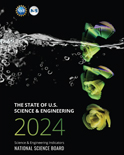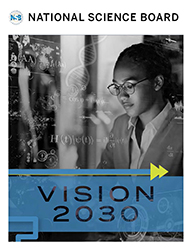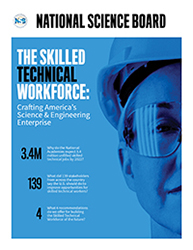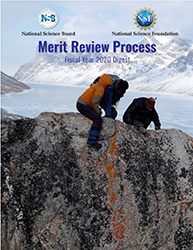Hearing on the Global Framework and Modes of Interaction
Summary
Friday, July 30, 1999
8:00a - 3:20p
National Science Foundation, Room 1235, Arlington, Virginia
Keynote Addresses: "What are the challenges and/or issues?"
NSF Director Colwell noted that international activities are one of the highest priorities of NSF. In the U.S., collaborations occur much more frequently within national borders than across them. The GEMINI project that involves seven countries was cited an excellent example of international collaboration. Due to cost and complexity, support of large-scale projects demands international collaboration. Expanding the number of countries contributing to the global scientific enterprise will help us achieve a globally integrated scientific system. But the U.S. must focus on the evolving role of developing countries to help achieve this goal. It is in the long-term scientific interest of the U.S. to do so. Colwell posed three questions for the TF to consider: 1) What models might NSF adopt to facilitate the joint funding of international cooperation? 2) How can NSF involve more younger scientists and engineers in international cooperative scientific research and education? and 3) Should the NSF devote resources to establish partnerships with USAID, the World Bank, the Department of State, private foundations, etc. in order to make available scientific expertise?
Bromley asserted that science and technology was lacking in U.S. foreign policy. Consequently, this has caused difficulty in the past and will continue to do so in the future. Because the U.S. does not consider science and technology an integral part of its foreign policy, the Department of State (DOS) does not seek Foreign Service Officers with backgrounds in science to fill its science positions. Bromley recalled that during the Reagan Administration, an Executive Order to fill science posts with scientists was ignored. An idea to use the Foreign Commercial Service (FCS) to gather scientific information and data failed; NSB and NSF should try to revive this idea with DOS. Due to the lack of emphasis and integration of science and technology in foreign policy, the U.S. has become known as an unreliable partner in some major international projects; the International Space Station is an example of this, with design changes made by the U.S. without consulting its partners. The U.S. needs better communication with its partners.
I. Panel: Role and Responsibilities of the U.S. Department of State
Boright stated that the NAS report on science at DOS is nearly completed and should be available in September. In his view, "science for policy" and "policy for science" overlap extensively. In the case of the former (science for policy), we must have a system for the global science community to integrate itself. This, however, cannot be motivated by DOS and U.S. Embassies entirely. DOS should be interested in doing "policy for science." DOS can be a player, but scientists will need to do the major work in this regard. Key issue is money. DOS has no money to fund international activities.
Nichols stated that the theme for this panel has been reviewed many times before, but getting changes implemented has and will be difficult. Quality of DOS staff work for international projects should be first-rate and uniform – it currently is not. Foreign Service Officers and Ambassadors do S&T but do not have much time to do it well. Nichols recommended clarifying not only DOS, but also government-wide objectives in S&T, setting priorities, and advocating needed resources. DOS needs more resources and not just in science. In the next century, the roles of various agencies involved in science will change: as the DOS role diminishes, the role of NSF and others will need to expand. OSTP must also increase its role. Currently, S&T in international affairs are not thriving at either NSF or DOS according to Nichols.
Ratchford reviewed previous reports on the subject. Process for integrating policy and science is very weak in the U.S. US technical agencies should be tasked to meet science policy needs of DOS. The NSF should play a special role in seconding staff to overseas posts as NSF has the human resources to do this.
West stated that resource constraints are extreme at DOS. Negotiations consume the bulk of staff time and demands are increasing as multilateral environmental issues proliferate. Since its creation in 1973, DOS/OES has initiated hundreds of bilateral and multilateral science activities. The role of DOS is to gather and use scientific information; science feeds the policymaking process. Science is one of the major foreign policy goals. Antarctic Treaty is an example of this. There are also science-focused international activities that support foreign policy for science (i.e., the Space Station). There is a clear need to strengthen DOS partnerships with technical agencies.
Rock gave the first presentation providing the perspective of an Embassy Science counselor. The function of Embassy Science Officers defies description as the role and function of a science officer have changed dramatically over the years. Science Officers actually occupy positions with special emphasis on issues with technical consequence; they are not science positions per se. Because S&T has helped transform world economies, EST offices do S&T as it helps in the development of U.S. foreign policy. Addressing the promise of biotechnology is one example of this, however, the advancement of science is not the mission of a Science Officer. Science literacy is needed in science posts rather than scientists. Foreign Service Officers (FSOs) need to be able to distinguish a technical issue from a policy one. In his current capacity, Rock serves the needs of 23 technical US agencies.
Maxwell saw his role as Science Counselor as that of an advisor, first to the Ambassador and then to main State. He also provided advice to other federal agencies (i.e., OSTP) and non-government sectors. Maxwell stated that a science background is necessary in order to recognize opportunities. DOS needs to re-establish the Science Deputy Assistant Secretary (DAS) position in OES, perhaps as the Principal DAS. Additionally, DOS needs to recruit FSOs with science credentials. Finally, and most importantly, a clear, strong signal must be sent within and outside of DOS that science is a key component of U.S. foreign policy.
DiCapua described in some detail the work he did for a diverse clientele (i.e., NOAA, DOE, HHS) while he was Science Counselor in China. All issues that he worked on were rife with technical and foreign policy concerns. He said his biggest challenge was dealing with the political volatility of issues. "One size fits all" philosophy does not work well in Embassies; what it takes to be a successful Science Counselor in Beijing is not necessarily the same thing it takes to become a successful Science Counselor in Paris. DiCapua agreed with the idea of having a cadre of seconded officers for particular embassies.
Due to the great number of visitors he received, Zimmerman viewed his role as EST Minister Counselor in Moscow as more of a tour guide than a working scientist. In order to meet their specific needs overseas, Zimmerman remarked that USDA established the Foreign Agricultural Service (FAS) and DOC established the Foreign Commercial Service (FCS). In essence, they have created their own mini State Departments. Zimmerman suggested that NSF may wish to consider doing something similar.
II. Panel: U. S. Government agencies modes of Interaction
Etter stated that research at DOD is focused on security threats for the 21st century and that DOD international activities involve primarily research on materials, sensors and electronics, and telecommunications. DOD, S&T is a partnership with service labs, DARPA, universities, and industries. She also described programs with other government agencies (i.e., DOE, NASA) and other nations.
Hrynkow stated that the mission of the NIH is to uncover new knowledge that will lead to better health for all humanity. The Fogarty International Center (FIC) is devoted entirely to international activities. NIH mechanisms for research support involve competitive grants and contracts, and training (intramural and extramural). At any given moment, there are 2000-3000 foreign scientists on the NIH campus, all of them paid for by NIH at a cost of $100 million per year. Fully half of all postdocs at NIH are from other countries. NIH works all over the world. The AIDS International Training and Research Program is a model for advancing global health agenda. The Biodiversity Program, cosponsored by AID and NSF, screens tropical flora and fauna for new drugs. The Multilateral Initiative on Malaria involves the EU, Japan, and Africa. Nearly $70 million dollars is devoted each year to support scientists from the developing world. In development are plans for partnerships in Health and Economics, Bioethics, Genomics, and Clinical Research. NIH also partners with NSF on the Ecology of Infectious Diseases.
Schmitten described how NOAA is collaborative by nature and how NOAA is de-centralized with respect to international affairs. NOAA's international mission is environmental assessment and prediction, and environmental stewardship. Budgetary constraints limit NOAA's involvement internationally. NOAA is working with AID, USGS, and NSF on a number of international projects.
Price described how the DOE international mission is woven into all of their activities: national security, energy, and environmental monitoring. International offices are found throughout DOE divisions, however, international activities account for less than 1% of the DOE total budget. Work with developing countries was reborn under Clinton and many new agreements were signed. The new Secretary is interested in involving developing countries especially with regard to implementing the Kyoto Protocol. DOE and other agencies need to rethink strategies on how to better communicate science goals to the public in order to avoid international embarrassments such as SSC. DOE is in favor of sending more technical people to Embassies but sometimes DOS balks at accepting them.
O'Brien stated that NASA has 3000 international agreements with over 100 nations. Benefits to NASA are pooling of financial resources and access to foreign sites. International cooperation does have downsides: increase in management complexity, technical and programmatic risks as well as political risk. Guidelines for international cooperation must be mutually beneficial, partners must be government agencies, and project must have technical merit. Best current example of international cooperation at NASA is the International Space Station (est. total cost = $50-60 billion) involving 15 nations working through 5 space agencies.
Hecht described the international mission of EPA: 1) protect U.S. citizens along U.S. borders; 2) reduce global threats; (3) reduce cost of environmental protection in U.S.; 4) promote U.S. technology and services abroad; and 5) strengthen environmental protection overseas. EPA is very decentralized with multi-office mission responsibilities. EPA utilizes a number of modalities for international cooperation: technical assistance, training and capacity building, industrial ecology related to zero waste, and trade and environment issues, and research, both basic and applied. Hecht then listed a number of examples of international activities at EPA, some of which included developing countries. Typically, US agencies are not fleet-footed enough to take advantage of opportunities, especially with developing countries.
Luncheon Speaker: Dr. Michael Quear, "Congressional Perspectives on Global S&E"
Quear contends that Congressional support for international science cooperation is probably as nebulous and bifurcated as it is within the Administration. Due to the passing of George Brown, he fears that international science cooperation has lost its biggest supporter on the Hill and there is no one poised to fill the void. Part of the problem with international science cooperation in Congress is that the definition of what is international science cooperation varies from person to person and agency to agency. Quear believes that the most successful partnership in science for the U.S. is with Israel. This is due to the fact that a bi-national science endowment was bestowed by the USG back in 1976 and that the interest generated from the endowment supports the science partnership. There is no annual appropriation process and the Israelis feel they are equal partners. There is no similar model for any other country. Congressional funding for international science cooperation is not the problem; Quear has never seen any appropriations bill where the budget request for international activities was ever cut. The problem is getting agencies to set priorities and submit requests for international activities. He noted that Congress rarely receives any budget requests from the agencies specifically for international activities.
III. The U.S. Government Policy Formulation Process
Jones discussed three questions: 1) Is there a dichotomy between science for policy and policy for science? Her short answer was "Yes" and "No". It depends on where you are in a particular process, what issues you're dealing with, the situation, the country - it's highly variable. At the highest level of policy objectives, there is consistency. 2) How does the current science policy process work? Jones described the National Science and Technology Council (NSTC), its Committee on International Science, Engineering, and Technology (CISET), and the role of the Office of Science and Technology Policy (OSTP). OSTP is the lead within the White House for science policy. OSTP is both proactive and reactive. OSTP connections to agencies are as important as OSTP connections to the White House. Congress is a player in the process, and is constantly asking questions and providing suggestions. Highly technical issues are oftentimes easier to deal with than political or bureaucratic ones. The process identifies and tries to address long-term issues. The problem is really how to maintain momentum on a longer-term issue when you have so many competing issues. 3) What are the specific needs of the U.S. science and technology community in the international setting? Most importantly, "doors" need to open for scientists; this is what DOS does. Scientists also need resources for international activities. Who pays? What is really needed are more knowledgeable spokespeople for scientists to represent them in the international setting. More communication on the value of S&T is also needed. Industry does not always value international experience.
According to Morgenstern, DOS is not now, never has been, and probably never will be, considered a scientific agency. Five US agencies account for over 50% of the S&T budget, and DOS is not among them. He believes there is a continuum of science for policy and policy for science at DOS. Science goals for DOS: ensure that policymakers have ready access to information and analysis, and that this information is incorporated into policies; helping to organize large projects; facilitate the S&T-type agreements by engaging in the political and diplomatic connections necessary to make scientific exchanges work; and build institutional connections essential for the long-term strengthening of science at DOS. Near-term objectives: bring in a senior science advisor; develop roundtables with scientists and senior DOS officials (one such roundtable has already been held); and improve science training of DOS officials. Only 5-6% of DOS officials have a science degree. However, a critical mass of trained people does not necessarily ensure that good science will follow.
Decker stated that international collaboration is a very integral part of the domestic programs at DOE. However, a separate budget for international activities at DOE would never make it through the budget process. Two largest areas for international collaboration are high-energy physics and fusion research. The most recent large international collaboration is the DOE/NSF partnership in constructing the large hadron collider (LHC). Foreign policy considerations are not usually the driver for science projects, but sometimes they can help initiate them (i.e., Japan, China, and Russia). Curiously, throughout the Cold War, DOE collaboration with Russia on fusion research and high-energy physics continued. At DOE, cooperative activities are identified at the scientific level and then brought to the Office of Science. For example, the DOE/NSF agreement on the LHC was done this way and has worked well. The most difficult part was dealing with Congress. Other countries that have parliamentary systems do not understand why we have such problems. ITER is an example of a well conceived, large international project that the US will no longer be part of due to a changeover in Congress. Foreign support for large projects is essential, but it is very difficult to maintain political support in the U.S. for long-term projects. It is also difficult to get agencies to come to the table on large projects because they have to have a vested interest. For most fields of science, scientists cannot make significant international cooperation happen by them; government involvement is essential.
NSB/TFISE-99-21




